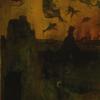
Posted
Is there a way in Synfire for recording seperatedly a melody , chords and bass notes on different tracks and then put all seperated tracks together on one track to get one picture.
No, its not possible , because the tracks use the same phrase editor over again with a different octave position if recorded seperatedly.
So only a recorded midi piano track ( chord + melody.. a bass line can be added )imported in Synfyre could be a base for a piano composition.
I do have a lot of them and lets look if i can make progress with this basis.
Thu, 2021-05-13 - 15:10 Permalink
HI, I look at what you suppose to do. I open two edit window of two instrument and placed them in same zoom level and you could have good control what you see and done. If you have a large display you could have more edit window open!
Thu, 2021-05-13 - 17:50 Permalink
Hi, thanks
The idea is to build up, say a 4 bar chord progression with a melody on top and a bass note on bottom
So you get a melody, chords and a bass line ( from chord root notes )
To see this whole picture in the right octaves in one track to see in Synfire seems to be not possible ?
melody : c4-c5
chords : c2-c4
bass : c1-c2
Thu, 2021-05-13 - 19:34 Permalink
check out the tutorial (https://users.cognitone.com/tutorial/compose-piano-theme) pretty much shows what you want at abot 8:20.
Remember you can change the playing range low, mid, high for a phrase, instrument and change the sweet spot of the range for an instument, also the notes get influenced by the progression. However it does colour code the different parts, bass, chords, melody, etc.
Thu, 2021-05-13 - 19:54 Permalink
Good to see this video back!
It is different then in DAW like Cubase where all notes are( can be) placed together and where the note position are positioned against eachother in the right octaves
I must practice a piano example workflow from A DAW into Synfire ...
Thu, 2021-05-13 - 20:15 Permalink
yeah can be hard to imagine what's going on just looking at figures as they dont represent the note that's being played or even when it is being played as there are other parameters that influence that. For instance, playing range, harmony, voice leading, transpose, rhythem, etc. You could always just drag and drop it into your daw or record it into your daw where all of that will be resolved and you will see static notes. Alternatively export it via lilipond and you will get a full score.
Mind you if you are like me, then I can not tell what a piece sounds like just from looking at a score, so the synfire view is of more use.
Thu, 2021-05-13 - 21:56 Permalink
Going from Synfire to a DAW during composing in Synfire is not what i want.
Yeah, it must be done all in Synfire ...
Well, when i look at the key editor in Cubase seeing a piano example i can see how its buildup as seen in this example
Writing & mixing a modern piano track (composingtips.com)
Its trying to adapt the workflow of the DAW to Synfire for the composition ( not for the mixing , because Cubase is better suited for this then Synfire )
Thu, 2021-05-13 - 23:30 Permalink
Talking about the video from Cognitone : the concept of weak or strong notes is not yet clear for me
If note follows the voiceleading or less (not?) : strong - weak
In that respect it is not a really helpful video to understand all ins and outs..or do i miss something?
DAW workflow incorparating into Synfire ?
- a 4 bar bass figure from rootnotes chords
-adding 4 bar chord progression (Dm(1)-Bb(2)-Gmin(3) A(3 1/2 )-A7(3 3/4)-Dmin)(4) ( from video example) to start with: recording or typing in or palette
(note : there is something about chord abstraction ?
- a melody on top
A chord what is not following the chordprogression is standalone ( done by abstracting the concerning chord) ..
Fri, 2021-05-14 - 13:53 Permalink
I did see in the video from the pianoexample , that adding chords who are free of the chordprogressions controlling ., are named abstractions ( better : free chords)
In order to add those free chords , the chordprogression seems to be not active ( not lit ) : how to deactivate the chordprogression?
When you make a snapshot of a chord progression , the chordprogression is lit
Fri, 2021-05-14 - 14:38 Permalink
If the harmony parameter is dimmed then it means it's inherited from a parent container or the default harmony, typically C major. Snapshotting it creates a harmony parameter for the container that contains the snapshot. You can then change that and have it overide the parent containers chord progression.
Disable or weaken the voice leading to allow a wider range of notes outside the progression, there is also an option in the preferences that allows a wider interpretation but cant remember what that is called.
Fri, 2021-05-14 - 15:29 Permalink
Doesn't matter if the chordprogression is lit or not : its always active
That was i thinking on when i saw the piano video with the abstracted chords
Its adjusting the voice leading to getting the chords wider as i see it now.
If want to replicate ( attempt) the first 4 bars of a pianoexample i must try to get chords, what can be free editable


